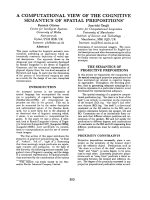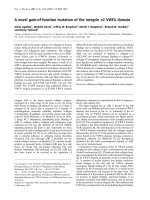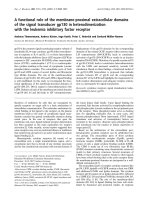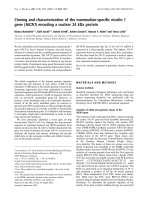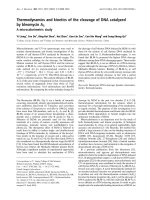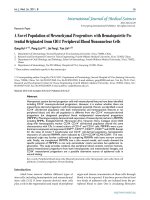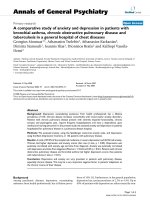Báo cáo y học: " A real-time view of the TAR:Tat:P-TEFb complex at HIV-1 transcription sites" ppsx
Bạn đang xem bản rút gọn của tài liệu. Xem và tải ngay bản đầy đủ của tài liệu tại đây (785.56 KB, 5 trang )
BioMed Central
Page 1 of 5
(page number not for citation purposes)
Retrovirology
Open Access
Short report
A real-time view of the TAR:Tat:P-TEFb complex at HIV-1
transcription sites
Dorothée Molle
1
, Paolo Maiuri
2
, Stéphanie Boireau
1
, Edouard Bertrand
1
,
Anna Knezevich
2
, Alessandro Marcello
†2
and Eugenia Basyuk*
†1
Address:
1
IGMM-CNRS UMR 5535, 1919, route de Mende, 34293 Montpellier, France and
2
Laboratory of Molecular Virology, ICGEB, Padriciano
99, 34012 Trieste, Italy
Email: Dorothée Molle - ; Paolo Maiuri - ; Stéphanie Boireau - ;
Edouard Bertrand - ; Anna Knezevich - ; Alessandro Marcello - ;
Eugenia Basyuk* -
* Corresponding author †Equal contributors
Abstract
HIV-1 transcription is tightly regulated: silent in long-term latency and highly active in acutely-
infected cells. Transcription is activated by the viral protein Tat, which recruits the elongation
factor P-TEFb by binding the TAR sequence present in nascent HIV-1 RNAs. In this study, we
analyzed the dynamic of the TAR:Tat:P-TEFb complex in living cells, by performing FRAP
experiments at HIV-1 transcription sites. Our results indicate that a large fraction of Tat present
at these sites is recruited by Cyclin T1. We found that in the presence of Tat, Cdk9 remained
bound to nascent HIV-1 RNAs for 71s. In contrast, when transcription was activated by PMA/
ionomycin, in the absence of Tat, Cdk9 turned-over rapidly and resided on the HIV-1 promoter
for only 11s. Thus, the mechanism of trans-activation determines the residency time of P-TEFb at
the HIV-1 gene, possibly explaining why Tat is such a potent transcriptional activator. In addition,
we observed that Tat occupied HIV-1 transcription sites for 55s, suggesting that the TAR:Tat:P-
TEFb complex dissociates from the polymerase following transcription initiation, and undergoes
subsequent cycles of association/dissociation.
Background
The human immunodeficiency virus type 1 (HIV-1) virus
can have latent and acute phases. Latent viruses remain in
infected organisms for a long time, and this prevents viral
clearance by anti-retroviral agents. The control of HIV-1
latency is highly dependent upon transcriptional regula-
tion: acutely-infected cells synthesize high levels of virus,
while latently-infected cells transcribe little or no viral
RNAs. HIV-1 transcription requires cellular co-factors, but
it is highly activated by the viral protein Tat (for review,
see [1,2]). In latent cells that do not express Tat, polymer-
ases initiating at the HIV-1 promoter are poorly processive
and do not transcribe the entire viral genome. However,
extra-cellular signals can drive latent cells into acute phase
by stimulating the HIV-1 promoter. Indeed, this induces
the production of small amounts of Tat, which then initi-
ates a positive feedback loop leading to full transcrip-
tional activation [3].
Tat activates transcription by recruiting the active form of
the positive transcription elongation factor P-TEFb to the
HIV-1 promoter [4]. P-TEFb is composed of a complex
Published: 30 May 2007
Retrovirology 2007, 4:36 doi:10.1186/1742-4690-4-36
Received: 4 May 2007
Accepted: 30 May 2007
This article is available from: />© 2007 Molle et al; licensee BioMed Central Ltd.
This is an Open Access article distributed under the terms of the Creative Commons Attribution License ( />),
which permits unrestricted use, distribution, and reproduction in any medium, provided the original work is properly cited.
Retrovirology 2007, 4:36 />Page 2 of 5
(page number not for citation purposes)
between Cyclin T1 (CycT1) and the kinase Cdk9, and Tat
directly binds CycT1 (see [5] for a review). Tat also binds
TAR (trans-activation-responsive region), an RNA element
present at the 5' end of all HIV-1 transcripts, and this
induces the formation of a ternary complex on nascent
RNAs, consisting of TAR, Tat, and P-TEFb. When incorpo-
rated in this complex, Cdk9 phosphorylates several com-
ponents of the transcription machinery, including the C-
terminal domain (CTD) of the large sub-unit of RNA
polymerase II (RNAPII), and elongation factors DSIF and
NELF [5]. This transforms RNAPII into a highly processive
enzyme, which can transcribe the entire viral genome.
P-TEFb is not the only partner of Tat. In particular, Tat has
also been shown to interact and recruit the histone acetyl-
transferases p300 and PCAF, which can modify chromatin
at the provirus integration site [1,2]. Moreover, Tat itself
can be acetylated at Lysines 28 and 50, and these modifi-
cations have been shown to regulate its interactions with
P-TEFb/TAR and PCAF [6-9].
While Tat and its various partners have been the subject of
many studies, how these complexes behave in vivo is still
a matter of debate. Indeed, several models currently exist.
It has been proposed that P-TEFb dissociates from the
HIV-1 gene following transcription initiation, while Tat
and PCAF become transferred to the elongating polymer-
ase [8]. In contrast, other models suggest that P-TEFb
remains associated with Tat in the elongating complex
[9,10]. To discriminate between these possibilities, we
developed an assay to analyze the dynamic of the Tat:P-
TEFb complex, directly in living cells and at HIV-1 tran-
scription sites.
Previous studies have shown that tagging RNAs with bind-
ing sites for the coat protein of phage MS2 allows its detec-
tion in living cells [11]. Thus, to visualize HIV-1
transcription sites, we tagged an HIV-1 vector with 24 MS2
binding sites [12]. This vector carried the elements
required for RNA production: the 5' LTR that contained
the TAR sequence, the major splice donor (SD1), the
packaging signal Ψ, the RRE, the splice acceptor A7, and
the 3' LTR that drives 3'-end formation. Stable clones
expressing this reporter construct were generated in U2OS
cells, and clones that showed robust trans-activation by
Tat were further analyzed (clone U2OS_HIV-1, [12]).
When expressed, the RNA was distributed homogenously
in the cytoplasm and concentrated in a bright spot in the
nucleoplasm. This spot corresponded to the transcription
site as it was labeled with probes directed against the non-
transcribed strand of the vector (data not shown, [12]).
When the reporter was activated by Tat, several proteins
accumulated at the HIV-1 transcription site, including Tat
itself, and its cofactors Cyclin T1 and Cdk9 (Figure 1A and
Figure 2). In contrast, this was not the case for either
HEXIM-1 or 7SK, which together form a complex that
inactivates P-TEFb ([13]; Figure 2). To test whether the
accumulation of Tat at the HIV-1 transcription site
depended on its interaction with Cyclin T1, we analyzed
the localization of a point mutant of Tat, unable to bind
Cyclin T1 (Tat C22G). U2OS_HIV-1 cells were transfected
with fluorescent versions of Tat, and HIV-1 transcription
was activated by treating cells with PMA/Ionomycin.
Remarkably, while wild-type Tat accumulated at HIV-1
transcription sites, the C22G mutant did not (Figure 1A).
Instead, it was homogeneously distributed in the nucleo-
plasm, even in the cells that contained high levels of nas-
cent RNAs. This indicated that interaction with CycT1 was
required to recruit Tat to HIV-1 transcription sites. In con-
trast, CycT1 and Cdk9 were recruited to the HIV-1 pro-
moter irrespective of its mode of activation (Tat or PMA/
Ionomycin; Figure 1C), consistent with the reported role
of P-TEFb in transcriptional elongation [5].
To evaluate the dynamic properties of the TAR:Tat:P-TEFb
complex, we performed experiments in live cells. We iden-
tified HIV-1 transcription sites with a yellow or red fluo-
rescent variant of MS2, and performed photobleaching
experiments (FRAP) on CFP and GFP-tagged versions of
Tat and Cdk9 (see Additional file 1). When Tat or Cdk9
were bleached in the nucleoplasm of U2OS cells, the flu-
orescence recovered quickly, indicating that these proteins
diffused rapidly through the nucleoplasm (Figure 1B and
1C). We then bleached Tat and Cdk9 at HIV-1 transcrip-
tion sites, to analyze the dynamic properties of the com-
plexes formed on nascent RNAs. The turn-over of Tat was
slow, as complete fluorescence recovery took nearly three
minutes (Figure 1B and Additional file 2). In the case of
Cdk9, we observed two contrasting situations depending
on the mode of activation of the HIV-1 promoter (Figure
1C). In the presence of Tat, Cdk9 recovery was also slow
and took several minutes to go to completion (see Addi-
tional file 3). In contrast, when HIV-1 transcription was
activated by PMA/ionomycin, Cdk9 was highly dynamic,
and recovery was complete within seconds.
To extract more information from the FRAP recovery
curves, each of them was fitted with a diffusion/binding
model [14]. The assumptions made were that the binding
sites are uniform within the volume of the spot and that
their number does not change in time at steady state. This
allowed us to derive some kinetic parameters: diffusion
coefficients (D), residency time (τb), and delay between
two binding events (τd; Table 1). The diffusion coeffi-
cients calculated for Tat and Cdk9 were similar and small,
although they differed substantially in mass, pointing to a
complex containing both proteins. We found that Tat
remained bound to nascent HIV-1 RNAs for 55 seconds,
and diffused for 60 seconds between two binding events.
Similarly, in the presence of Tat, Cdk9 resided for 71 sec-
Retrovirology 2007, 4:36 />Page 3 of 5
(page number not for citation purposes)
Dynamic of Tat and Cdk9 at HIV-1 transcription sitesFigure 1
Dynamic of Tat and Cdk9 at HIV-1 transcription sites. A-Accumulation of Tat, but not the C22G mutant, at
HIV-1 transcription sites. U2OS_HIV-1 cells were transfected with Tat-GFP or Tat(C22G)-GFP, and then induced 7h with
PMA/ionomycin. Cells were then fixed and hybridized in situ with a Cy3-labelled oligo probe against the MS2 repeat. The HIV-
1 transcription site corresponds to the focal accumulation labelled by the MS2 probe. Blue: dapi. Each field is 22 × 22 μm. B-
Dynamic of Tat at HIV-1 transcription sites. U2OS_HIV-1 cells were transfected with vectors expressing Tat-CFP and
MS2-YFP. Tat-CFP was then bleached, and recovery was analyzed by tracking transcription sites in 3D with a wide-field micro-
scope. Upper panel: colocalization of Tat-CFP and MS2-YFP in living cells (30 × 25μm). Middle panels: image sequence from a
FRAP experiment (time in second; each field is 30 × 25 μm). Graph: recovery curves in the nucleoplasm of transfected U2OS
cells (pink), or at the HIV-1 transcription site (blue). The best fit is shown in green. C-Dynamics of Cdk9 at HIV-1 tran-
scription sites. U2OS_HIV-1 cells were transfected with vectors expressing Cdk9-GFP and MS2-mCherry. Cdk9-GFP was
then bleached, and recovery was analyzed by tracking transcription sites in 3D with a wide-field microscope. Upper panel:
colocalization of Cdk9-GFP and MS2-mCherry in living cells (30 × 25 μm). Middle panels: image sequence from a FRAP exper-
iment (time in second; each field is 30 × 25 μm). Graph: recovery curves in the nucleoplasm of transfected U2OS cells (pink),
or at the HIV-1 transcription site. Blue: cells were transfected with Tat; Green: Tat was absent but cells were induced by PMA/
ionomycin.
Retrovirology 2007, 4:36 />Page 4 of 5
(page number not for citation purposes)
onds at HIV-1 transcription sites, but diffused for 142 sec-
onds between two binding events. This situation changed
dramatically when HIV-1 transcription was activated by
PMA/ionomycin, in the absence of Tat. In this case, P-
TEFb turn-over was rapid, as it remained bound to the
HIV-1 transcription site for only 11s. Since PMA/ionomy-
cin promotes transcription by activating NF-kB, which
directly recruits P-TEFb [5], a major conclusion of this
work is that the dynamic properties of P-TEFb depend on
its mode of recruitment to the HIV-1 promoter. It is inter-
esting to speculate that the higher stability of the
Tat:TAR:P-TEFb complex may account for the stronger
activation obtained with Tat. A similar case has been
observed for the transcription factor HSF (heat shock fac-
tor) in Drosophila [15]. Indeed, while HSF bound its tar-
get gene whether it is activated or not, the dynamic
properties of this interaction varied dramatically upon
transcriptional activation. This raises the possibility that it
is not only the binding of transcription factors to their tar-
get genes regulates transcription, but also the dynamic
properties of these events.
Our data show that Tat and P-TEFb remained bound to
nascent RNAs for about a minute. If HIV-1 transcription
proceeds with the previously described rate of 2 Kb/min,
then elongation through our reporter RNA would last
more than 2 minutes [16]. This raises the possibility that
the TAR:Tat:P-TEFb complex could be dissociated from
the polymerase before the gene is completely transcribed.
Following dissociation, the fate of Tat and Cdk9 is likely
to differ, as shown by their significant difference in τ
d
(Table 1). It is remarkable that Tat and Cdk9 have very
similar dynamics. This supports the idea that they remain
together in the elongating complex, rather then Tat being
transferred to the polymerase while P-TEFb dissociating
from it. Since chromatin immunoprecipitation data have
shown that Tat and P-TEFb are present with elongating
polymerases all along the gene [10], we suggest that Tat
and P-TEFb could undergo constant association and dis-
sociation cycles with TAR and the elongating polymerase.
Altogether, our data show that the TAR:Tat:P-TEFb com-
plex is remodeled during HIV-1 transcription. This work
opens an opportunity to study the kinetic properties of
factors involved in HIV-1 transcription, and could also be
extended to the analysis of the contribution of post-trans-
lational modifications to the dynamics of the Tat:P-TEFb
complex.
Abbreviations
HIV: human immunodeficiency virus
RNAPII: RNA polymerase II
CTD: C-terminal domain of RNAPII
FRAP: fluorescence recovery after photobleaching
Financial competing interests
The author(s) declare that they have no competing inter-
ests.
Authors' contributions
D. Molle, S. Boireau, E. Bertrand, and E. Basyuk per-
formed the FRAP experiments. D. Molle and A. Marcello
performed the localization in fixed cells. P. Maiuri did the
fitting of the FRAP curves. A. Knezevich realized the DNA
constructs. E. Basyuk wrote the first draft of the paper. A.
Marcello, E. Bertrand, and E. Basyuk elaborated the final
Hexim and 7SK are not recruited at the HIV-1 transcription siteFigure 2
Hexim and 7SK are not recruited at the HIV-1 tran-
scription site. U2OS_HIV-1 cells were transfected with
vectors expressing Tat alone (upper panel), or Tat and MS2-
GFP (middle and lower panels). 24h later, cells were fixed
and processed. Upper panel: cells were hybridized in situ
with fluorescent oligonucleotide probes detecting 7SK (red)
or the MS2 repeat (green). Middle and lower panels, cells
were labeled with antibodies against Hexim1 (red, middle
panel), or cyclin T1 (red, lower panel).
Table 1: Kinetic parameters of the fitted FRAP curves.
Tat Cdk9
(with Tat)
Cdk9
(with PMA/ionomycin)
Diffusion
coefficient
8 μm
2
/s 7 μm
2
/s 9 μm
2
/s
τ
b
55 s 71 s 11 s
τ
d
60 s 142 s 15 s
τ
b
corresponds to the residency time at the HIV-1 transcription site.
τ
d
corresponds to the time that separates two binding events at the
HIV-1 transcription site.
Publish with BioMed Central and every
scientist can read your work free of charge
"BioMed Central will be the most significant development for
disseminating the results of biomedical research in our lifetime."
Sir Paul Nurse, Cancer Research UK
Your research papers will be:
available free of charge to the entire biomedical community
peer reviewed and published immediately upon acceptance
cited in PubMed and archived on PubMed Central
yours — you keep the copyright
Submit your manuscript here:
/>BioMedcentral
Retrovirology 2007, 4:36 />Page 5 of 5
(page number not for citation purposes)
version. This work was conceived by E. Basyuk and A. Mar-
cello. All authors read and approved the final manuscript.
Additional material
Acknowledgements
We thank O. Bensaude for the gift of anti-Hexim antibodies. This work was
supported by NOE EURASNET. Support to A.M. was from EC STREP con-
sortium 012182, from a HFSP Young Investigators Grant, and from the
AIDS project of the ISS of Italy. E.B. was supported by a fellowship from
l'ANRS.
References
1. Marcello A, Zoppe M, Giacca M: Multiple modes of transcrip-
tional regulation by the HIV-1 Tat transactivator. IUBMB Life
2001, 51:175-181.
2. Jeang KT, Xiao H, Rich HA: Multifaceted activities of the HIV-1
transactivator of transcription, Tat. J Biol Chem 1999,
274:28837-28840.
3. Weinberger LS, Burnett JC, Toettcher JE, Arkin AP, Schaffer DV:
Stochastic gene expression in a lentiviral positive-feedback
loop: HIV-1 Tat fluctuations drive phenotypic diversity. Cell
2005, 122:169-182.
4. Wei P, Garber ME, Fang SM, Fischer WH, Jones KA: A novel CDK9-
associated C-type cyclin interacts directly with HIV-1 Tat
and mediates its high-affinity, loop-specific binding to TAR
RNA. Cell 1998, 92:451-462.
5. Peterlin PM, Price DH: Controlling the elongation phase of
transcription with P-TEFb. Mol Cell 2006, 23:297-305.
6. Ott M, Schnolzer M, Garnica J, Fischle W, Emiliani S, Rackwitz HR,
Verdin E: Acetylation of the HIV-1 Tat protein by p300 is
important for its transcriptional activity. Curr Biol 1999,
9:1489-1492.
7. Kiernan ER, Vanhulle C, Schiltz L, Adam L, Xiao H, Maudoux F,
Calomme C, Burny A, Nakatani Y, Jeang KT, et al.: HIV-1 tat tran-
scriptional activity is regulated by acetylation. Embo J 1999,
18:6106-6118.
8. Kaehlcke K, Dorr A, Hetzer-Egger C, Kiermer V, Henklein P, Schnoe-
lzer M, Loret E, Cole PA, Verdin E, Ott M: Acetylation of Tat
defines a cyclinT1-independent step in HIV transactivation.
Mol Cell 2003, 12:167-176.
9. Bres V, Tagami H, Peloponese JM, Loret E, Jeang KT, Nakatani Y, Emil-
iani S, Benkirane S, Kiernan RE: Differential acetylation of Tat
coordinates its interaction with the co-activators cyclin T1
and PCAF. Embo J 2002, 21:6811-6819.
10. Bres V, Gomes N, Pickle L, Jones K: A human splicing factor,
SKIP, associates with P-TEFb and enhances transcription
elongation by HIV-1 Tat. Genes Dev 2005, 19:1211-26.
11. Fusco D, Accornero N, Lavoie B, Shenoy S, Blanchard J, Singer R, Ber-
trand E:
Single mRNA molecules demonstrate probabilistic
movement in living mammalian cells. Curr Biol 2003, 13:161-7.
12. Chene I du, Basyuk E, Lin Y, Triboulet R, Knezevich R, Chable-Bessia
C, Mettling C, Baillat V, Reynes J, Corbeau P, et al.: Suv39H1 and
HP1gamma are responsible for chromatin-mediated HIV-1
transcriptional silencing and post-integration latency. EMBO
J 2007, 26:424-35.
13. Michels AA, Nguyen VT, Fraldi A, Labas V, Edwards M, Bonnet F,
Lania L, Bensaude O: MAQ1 and 7SK RNA interact with CDK9/
cyclin T complexes in a transcription-dependent manner.
Mol Cell Biol 2003, 23:.
14. Sprague BL, Pego RL, Stavreva DA, McNally JG: Analysis of binding
reactions by fluorescence recovery after photobleaching.
Biophys J 2004, 86:3473-3495.
15. Yao J, Munson K, Webb W, Lis J: Dynamics of heat shock factor
association with native gene loci in living cells. Nature 2006,
442:1050-3.
16. Tennyson CN, Klamut HJ, Worton RG: The human dystrophin
gene requires 16 hours to be transcribed and is cotranscrip-
tionally spliced. Nat Genet 1995, 9:184-190.
Additional file 1
Experimental procedures. Experimental procedures used in the study are
described.
Click here for file
[ />4690-4-36-S1.rtf]
Additional file 2
Recovery of Tat at HIV-1 transcription sites. GFP-Tat was bleached at
HIV-1 transcription site and stacks of images were taken every 3 seconds
during 3 minutes after the bleach to monitor the recovery.
Click here for file
[ />4690-4-36-S2.avi]
Additional file 3
Movie 2. Recovery of Cdk9 at HIV-1 transcription sites, in the presence of
Tat. CDK9-GFP was bleached at HIV-1 transcription site and stacks of
images were taken every 3 seconds during 3 minutes after the bleach to
monitor the recovery.
Click here for file
[ />4690-4-36-S3.avi]
